Nutrition and Wellness: Effective Communication Theories Report
VerifiedAdded on 2020/06/06
|9
|2548
|35
Report
AI Summary
This report delves into the critical role of effective communication in the field of nutrition, emphasizing its importance for nutritionists when interacting with clients. It begins by identifying potential barriers to effective communication, such as technical jargon, language differences, and misunderstandings in body language. The report then explores various skills and strategies that enhance communication, including the use of interpersonal and verbal communication techniques, active listening, and the importance of non-verbal cues. Furthermore, it presents different communication theories, specifically the linear and transactional models, explaining their application in nutrition and highlighting their strengths and weaknesses. The report also discusses the need to adapt communication styles to meet individual needs based on age, physical ability, and cognitive factors, with an emphasis on assertive communication. The conclusion reinforces the significance of effective communication in preventing misunderstandings and ensuring accurate information transfer, ultimately leading to improved client understanding and adherence to nutritional advice. Reference materials are provided at the end of the report.
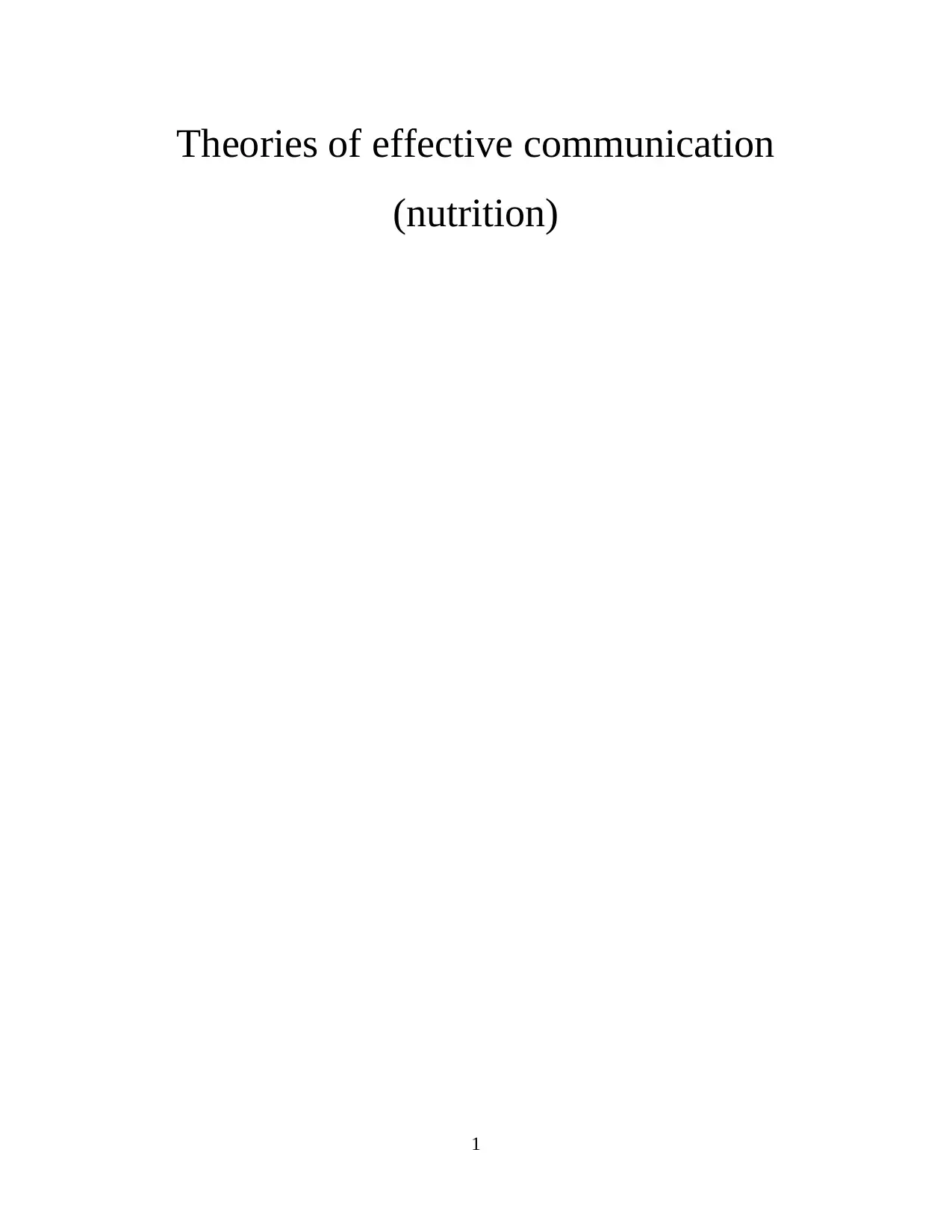
Theories of effective communication
(nutrition)
1
(nutrition)
1
Paraphrase This Document
Need a fresh take? Get an instant paraphrase of this document with our AI Paraphraser
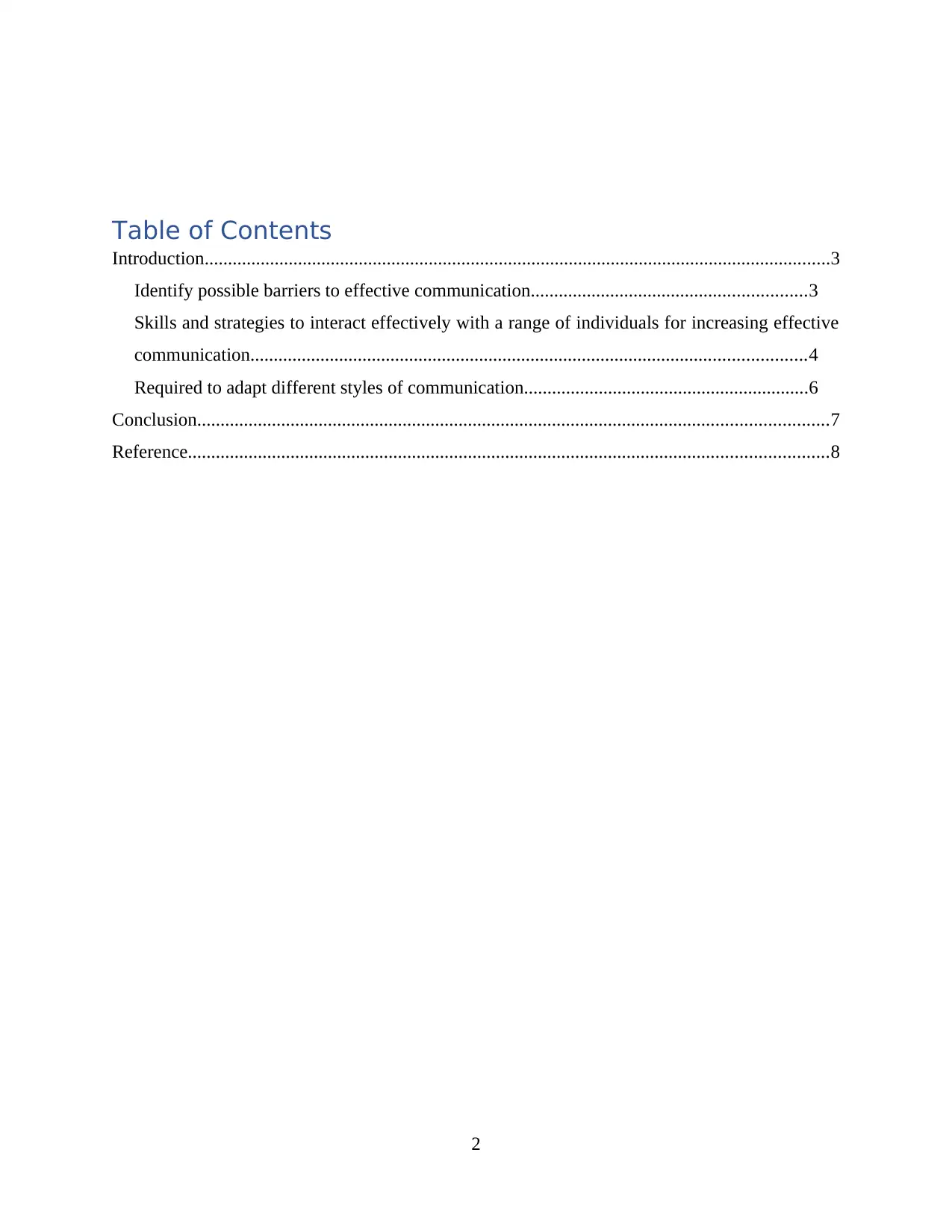
Table of Contents
Introduction......................................................................................................................................3
Identify possible barriers to effective communication...........................................................3
Skills and strategies to interact effectively with a range of individuals for increasing effective
communication.......................................................................................................................4
Required to adapt different styles of communication.............................................................6
Conclusion.......................................................................................................................................7
Reference.........................................................................................................................................8
2
Introduction......................................................................................................................................3
Identify possible barriers to effective communication...........................................................3
Skills and strategies to interact effectively with a range of individuals for increasing effective
communication.......................................................................................................................4
Required to adapt different styles of communication.............................................................6
Conclusion.......................................................................................................................................7
Reference.........................................................................................................................................8
2
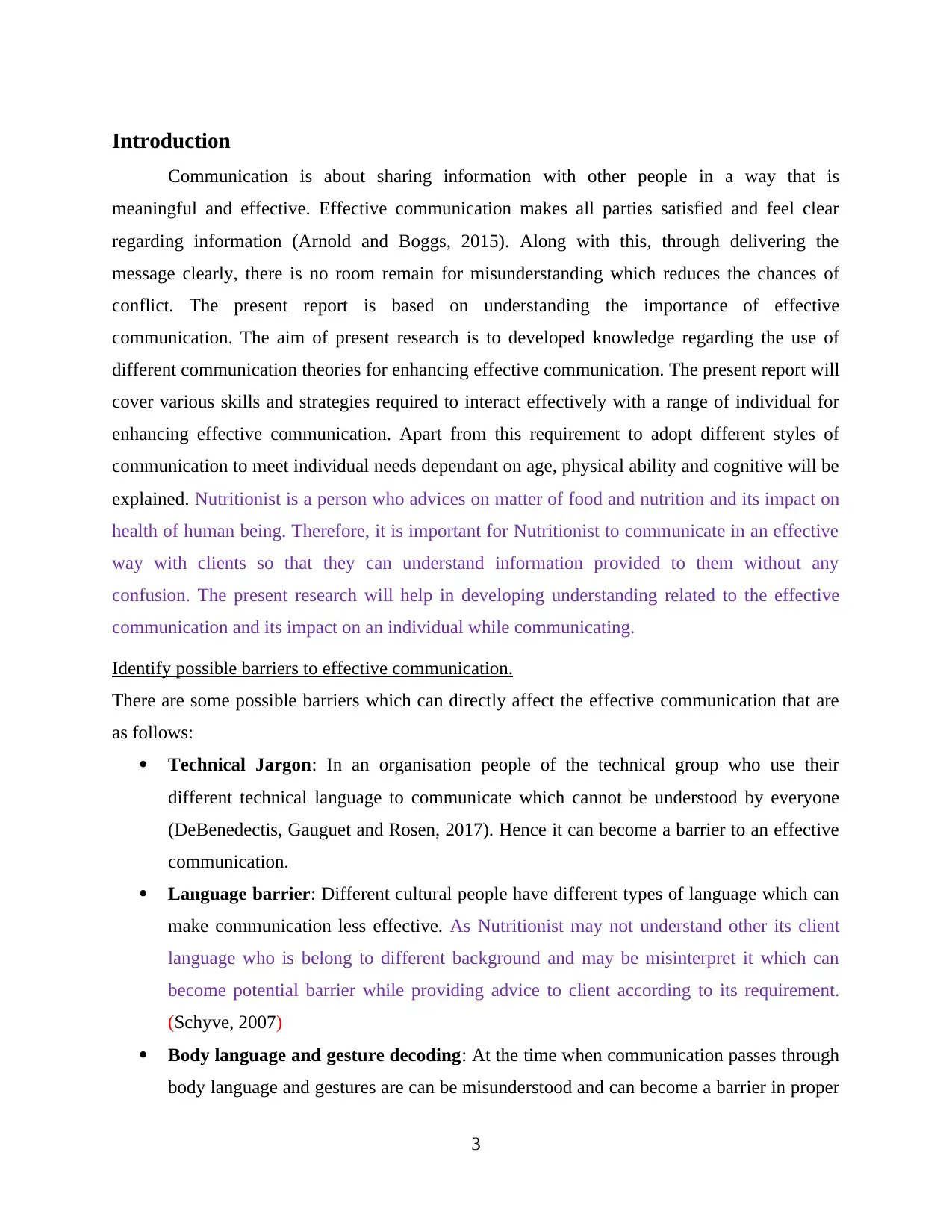
Introduction
Communication is about sharing information with other people in a way that is
meaningful and effective. Effective communication makes all parties satisfied and feel clear
regarding information (Arnold and Boggs, 2015). Along with this, through delivering the
message clearly, there is no room remain for misunderstanding which reduces the chances of
conflict. The present report is based on understanding the importance of effective
communication. The aim of present research is to developed knowledge regarding the use of
different communication theories for enhancing effective communication. The present report will
cover various skills and strategies required to interact effectively with a range of individual for
enhancing effective communication. Apart from this requirement to adopt different styles of
communication to meet individual needs dependant on age, physical ability and cognitive will be
explained. Nutritionist is a person who advices on matter of food and nutrition and its impact on
health of human being. Therefore, it is important for Nutritionist to communicate in an effective
way with clients so that they can understand information provided to them without any
confusion. The present research will help in developing understanding related to the effective
communication and its impact on an individual while communicating.
Identify possible barriers to effective communication.
There are some possible barriers which can directly affect the effective communication that are
as follows:
Technical Jargon: In an organisation people of the technical group who use their
different technical language to communicate which cannot be understood by everyone
(DeBenedectis, Gauguet and Rosen, 2017). Hence it can become a barrier to an effective
communication.
Language barrier: Different cultural people have different types of language which can
make communication less effective. As Nutritionist may not understand other its client
language who is belong to different background and may be misinterpret it which can
become potential barrier while providing advice to client according to its requirement.
(Schyve, 2007)
Body language and gesture decoding: At the time when communication passes through
body language and gestures are can be misunderstood and can become a barrier in proper
3
Communication is about sharing information with other people in a way that is
meaningful and effective. Effective communication makes all parties satisfied and feel clear
regarding information (Arnold and Boggs, 2015). Along with this, through delivering the
message clearly, there is no room remain for misunderstanding which reduces the chances of
conflict. The present report is based on understanding the importance of effective
communication. The aim of present research is to developed knowledge regarding the use of
different communication theories for enhancing effective communication. The present report will
cover various skills and strategies required to interact effectively with a range of individual for
enhancing effective communication. Apart from this requirement to adopt different styles of
communication to meet individual needs dependant on age, physical ability and cognitive will be
explained. Nutritionist is a person who advices on matter of food and nutrition and its impact on
health of human being. Therefore, it is important for Nutritionist to communicate in an effective
way with clients so that they can understand information provided to them without any
confusion. The present research will help in developing understanding related to the effective
communication and its impact on an individual while communicating.
Identify possible barriers to effective communication.
There are some possible barriers which can directly affect the effective communication that are
as follows:
Technical Jargon: In an organisation people of the technical group who use their
different technical language to communicate which cannot be understood by everyone
(DeBenedectis, Gauguet and Rosen, 2017). Hence it can become a barrier to an effective
communication.
Language barrier: Different cultural people have different types of language which can
make communication less effective. As Nutritionist may not understand other its client
language who is belong to different background and may be misinterpret it which can
become potential barrier while providing advice to client according to its requirement.
(Schyve, 2007)
Body language and gesture decoding: At the time when communication passes through
body language and gestures are can be misunderstood and can become a barrier in proper
3
⊘ This is a preview!⊘
Do you want full access?
Subscribe today to unlock all pages.

Trusted by 1+ million students worldwide
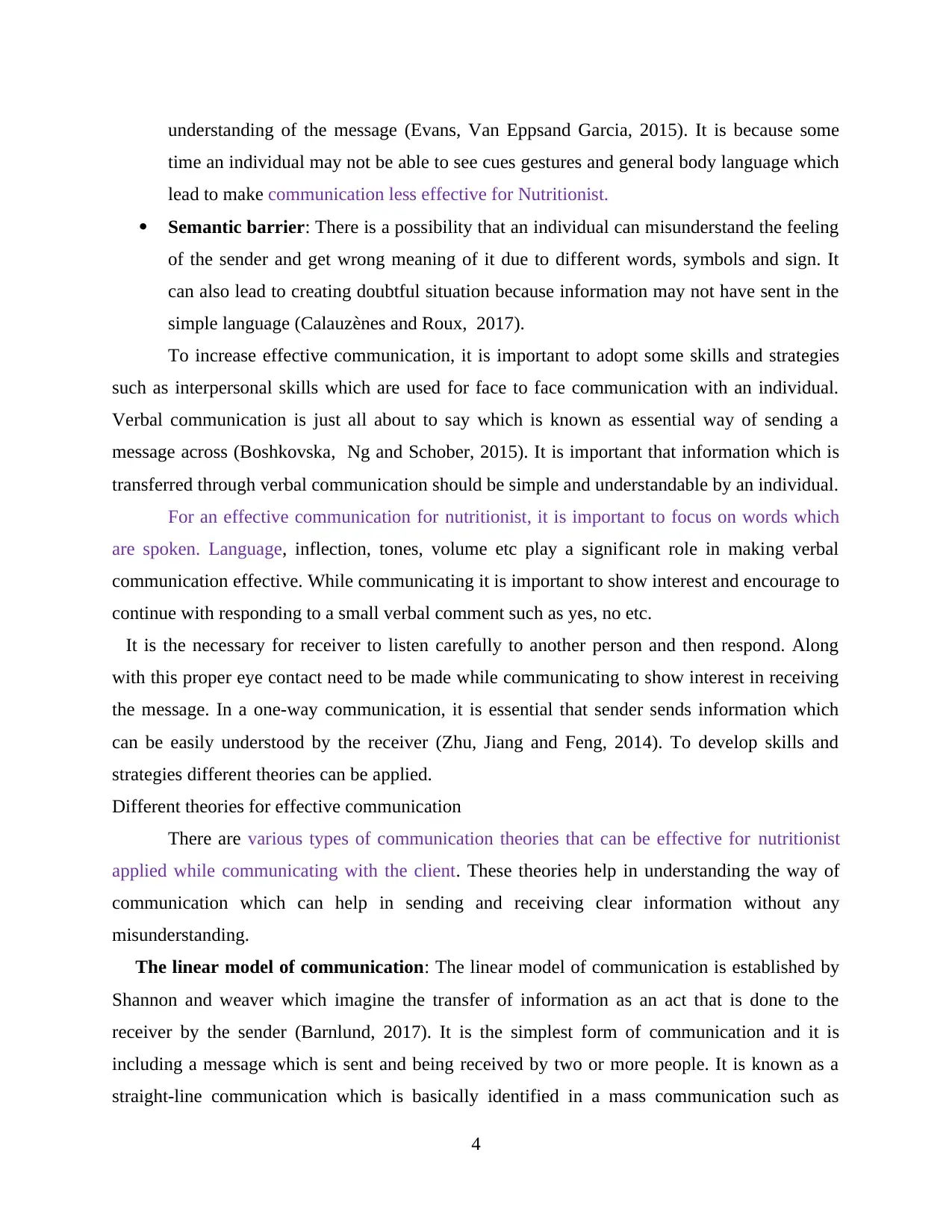
understanding of the message (Evans, Van Eppsand Garcia, 2015). It is because some
time an individual may not be able to see cues gestures and general body language which
lead to make communication less effective for Nutritionist.
Semantic barrier: There is a possibility that an individual can misunderstand the feeling
of the sender and get wrong meaning of it due to different words, symbols and sign. It
can also lead to creating doubtful situation because information may not have sent in the
simple language (Calauzènes and Roux, 2017).
To increase effective communication, it is important to adopt some skills and strategies
such as interpersonal skills which are used for face to face communication with an individual.
Verbal communication is just all about to say which is known as essential way of sending a
message across (Boshkovska, Ng and Schober, 2015). It is important that information which is
transferred through verbal communication should be simple and understandable by an individual.
For an effective communication for nutritionist, it is important to focus on words which
are spoken. Language, inflection, tones, volume etc play a significant role in making verbal
communication effective. While communicating it is important to show interest and encourage to
continue with responding to a small verbal comment such as yes, no etc.
It is the necessary for receiver to listen carefully to another person and then respond. Along
with this proper eye contact need to be made while communicating to show interest in receiving
the message. In a one-way communication, it is essential that sender sends information which
can be easily understood by the receiver (Zhu, Jiang and Feng, 2014). To develop skills and
strategies different theories can be applied.
Different theories for effective communication
There are various types of communication theories that can be effective for nutritionist
applied while communicating with the client. These theories help in understanding the way of
communication which can help in sending and receiving clear information without any
misunderstanding.
The linear model of communication: The linear model of communication is established by
Shannon and weaver which imagine the transfer of information as an act that is done to the
receiver by the sender (Barnlund, 2017). It is the simplest form of communication and it is
including a message which is sent and being received by two or more people. It is known as a
straight-line communication which is basically identified in a mass communication such as
4
time an individual may not be able to see cues gestures and general body language which
lead to make communication less effective for Nutritionist.
Semantic barrier: There is a possibility that an individual can misunderstand the feeling
of the sender and get wrong meaning of it due to different words, symbols and sign. It
can also lead to creating doubtful situation because information may not have sent in the
simple language (Calauzènes and Roux, 2017).
To increase effective communication, it is important to adopt some skills and strategies
such as interpersonal skills which are used for face to face communication with an individual.
Verbal communication is just all about to say which is known as essential way of sending a
message across (Boshkovska, Ng and Schober, 2015). It is important that information which is
transferred through verbal communication should be simple and understandable by an individual.
For an effective communication for nutritionist, it is important to focus on words which
are spoken. Language, inflection, tones, volume etc play a significant role in making verbal
communication effective. While communicating it is important to show interest and encourage to
continue with responding to a small verbal comment such as yes, no etc.
It is the necessary for receiver to listen carefully to another person and then respond. Along
with this proper eye contact need to be made while communicating to show interest in receiving
the message. In a one-way communication, it is essential that sender sends information which
can be easily understood by the receiver (Zhu, Jiang and Feng, 2014). To develop skills and
strategies different theories can be applied.
Different theories for effective communication
There are various types of communication theories that can be effective for nutritionist
applied while communicating with the client. These theories help in understanding the way of
communication which can help in sending and receiving clear information without any
misunderstanding.
The linear model of communication: The linear model of communication is established by
Shannon and weaver which imagine the transfer of information as an act that is done to the
receiver by the sender (Barnlund, 2017). It is the simplest form of communication and it is
including a message which is sent and being received by two or more people. It is known as a
straight-line communication which is basically identified in a mass communication such as
4
Paraphrase This Document
Need a fresh take? Get an instant paraphrase of this document with our AI Paraphraser
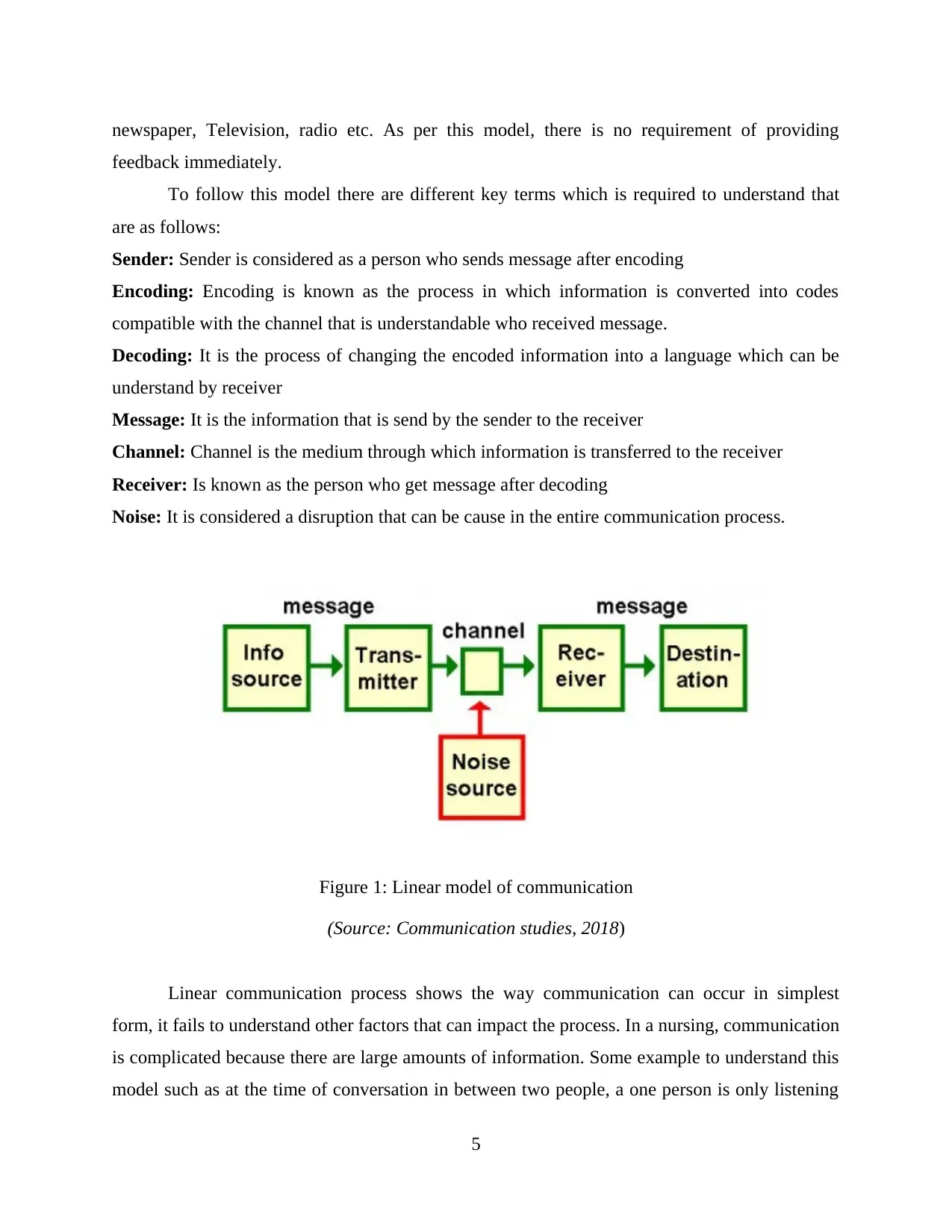
newspaper, Television, radio etc. As per this model, there is no requirement of providing
feedback immediately.
To follow this model there are different key terms which is required to understand that
are as follows:
Sender: Sender is considered as a person who sends message after encoding
Encoding: Encoding is known as the process in which information is converted into codes
compatible with the channel that is understandable who received message.
Decoding: It is the process of changing the encoded information into a language which can be
understand by receiver
Message: It is the information that is send by the sender to the receiver
Channel: Channel is the medium through which information is transferred to the receiver
Receiver: Is known as the person who get message after decoding
Noise: It is considered a disruption that can be cause in the entire communication process.
Figure 1: Linear model of communication
(Source: Communication studies, 2018)
Linear communication process shows the way communication can occur in simplest
form, it fails to understand other factors that can impact the process. In a nursing, communication
is complicated because there are large amounts of information. Some example to understand this
model such as at the time of conversation in between two people, a one person is only listening
5
feedback immediately.
To follow this model there are different key terms which is required to understand that
are as follows:
Sender: Sender is considered as a person who sends message after encoding
Encoding: Encoding is known as the process in which information is converted into codes
compatible with the channel that is understandable who received message.
Decoding: It is the process of changing the encoded information into a language which can be
understand by receiver
Message: It is the information that is send by the sender to the receiver
Channel: Channel is the medium through which information is transferred to the receiver
Receiver: Is known as the person who get message after decoding
Noise: It is considered a disruption that can be cause in the entire communication process.
Figure 1: Linear model of communication
(Source: Communication studies, 2018)
Linear communication process shows the way communication can occur in simplest
form, it fails to understand other factors that can impact the process. In a nursing, communication
is complicated because there are large amounts of information. Some example to understand this
model such as at the time of conversation in between two people, a one person is only listening
5
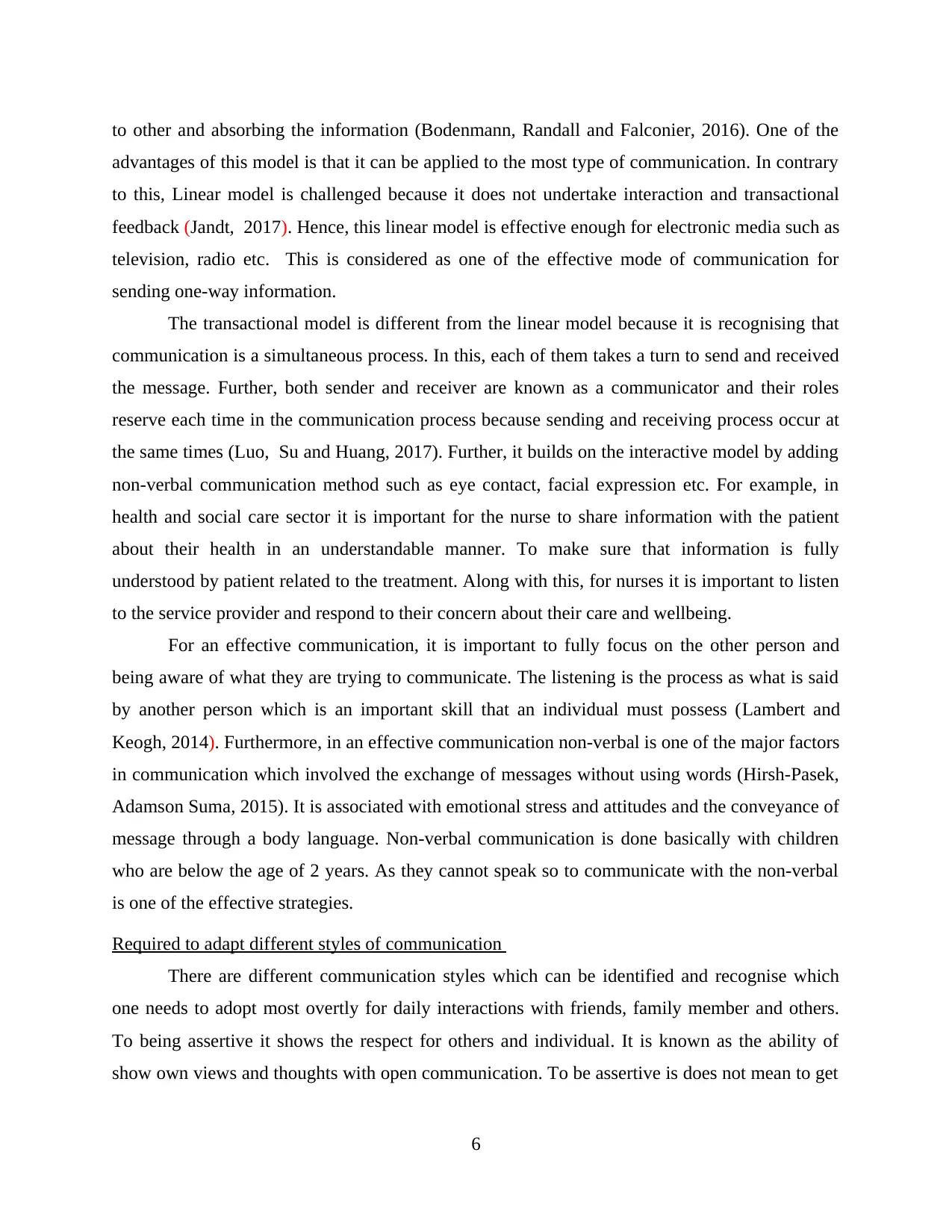
to other and absorbing the information (Bodenmann, Randall and Falconier, 2016). One of the
advantages of this model is that it can be applied to the most type of communication. In contrary
to this, Linear model is challenged because it does not undertake interaction and transactional
feedback (Jandt, 2017). Hence, this linear model is effective enough for electronic media such as
television, radio etc. This is considered as one of the effective mode of communication for
sending one-way information.
The transactional model is different from the linear model because it is recognising that
communication is a simultaneous process. In this, each of them takes a turn to send and received
the message. Further, both sender and receiver are known as a communicator and their roles
reserve each time in the communication process because sending and receiving process occur at
the same times (Luo, Su and Huang, 2017). Further, it builds on the interactive model by adding
non-verbal communication method such as eye contact, facial expression etc. For example, in
health and social care sector it is important for the nurse to share information with the patient
about their health in an understandable manner. To make sure that information is fully
understood by patient related to the treatment. Along with this, for nurses it is important to listen
to the service provider and respond to their concern about their care and wellbeing.
For an effective communication, it is important to fully focus on the other person and
being aware of what they are trying to communicate. The listening is the process as what is said
by another person which is an important skill that an individual must possess (Lambert and
Keogh, 2014). Furthermore, in an effective communication non-verbal is one of the major factors
in communication which involved the exchange of messages without using words (Hirsh-Pasek,
Adamson Suma, 2015). It is associated with emotional stress and attitudes and the conveyance of
message through a body language. Non-verbal communication is done basically with children
who are below the age of 2 years. As they cannot speak so to communicate with the non-verbal
is one of the effective strategies.
Required to adapt different styles of communication
There are different communication styles which can be identified and recognise which
one needs to adopt most overtly for daily interactions with friends, family member and others.
To being assertive it shows the respect for others and individual. It is known as the ability of
show own views and thoughts with open communication. To be assertive is does not mean to get
6
advantages of this model is that it can be applied to the most type of communication. In contrary
to this, Linear model is challenged because it does not undertake interaction and transactional
feedback (Jandt, 2017). Hence, this linear model is effective enough for electronic media such as
television, radio etc. This is considered as one of the effective mode of communication for
sending one-way information.
The transactional model is different from the linear model because it is recognising that
communication is a simultaneous process. In this, each of them takes a turn to send and received
the message. Further, both sender and receiver are known as a communicator and their roles
reserve each time in the communication process because sending and receiving process occur at
the same times (Luo, Su and Huang, 2017). Further, it builds on the interactive model by adding
non-verbal communication method such as eye contact, facial expression etc. For example, in
health and social care sector it is important for the nurse to share information with the patient
about their health in an understandable manner. To make sure that information is fully
understood by patient related to the treatment. Along with this, for nurses it is important to listen
to the service provider and respond to their concern about their care and wellbeing.
For an effective communication, it is important to fully focus on the other person and
being aware of what they are trying to communicate. The listening is the process as what is said
by another person which is an important skill that an individual must possess (Lambert and
Keogh, 2014). Furthermore, in an effective communication non-verbal is one of the major factors
in communication which involved the exchange of messages without using words (Hirsh-Pasek,
Adamson Suma, 2015). It is associated with emotional stress and attitudes and the conveyance of
message through a body language. Non-verbal communication is done basically with children
who are below the age of 2 years. As they cannot speak so to communicate with the non-verbal
is one of the effective strategies.
Required to adapt different styles of communication
There are different communication styles which can be identified and recognise which
one needs to adopt most overtly for daily interactions with friends, family member and others.
To being assertive it shows the respect for others and individual. It is known as the ability of
show own views and thoughts with open communication. To be assertive is does not mean to get
6
⊘ This is a preview!⊘
Do you want full access?
Subscribe today to unlock all pages.

Trusted by 1+ million students worldwide
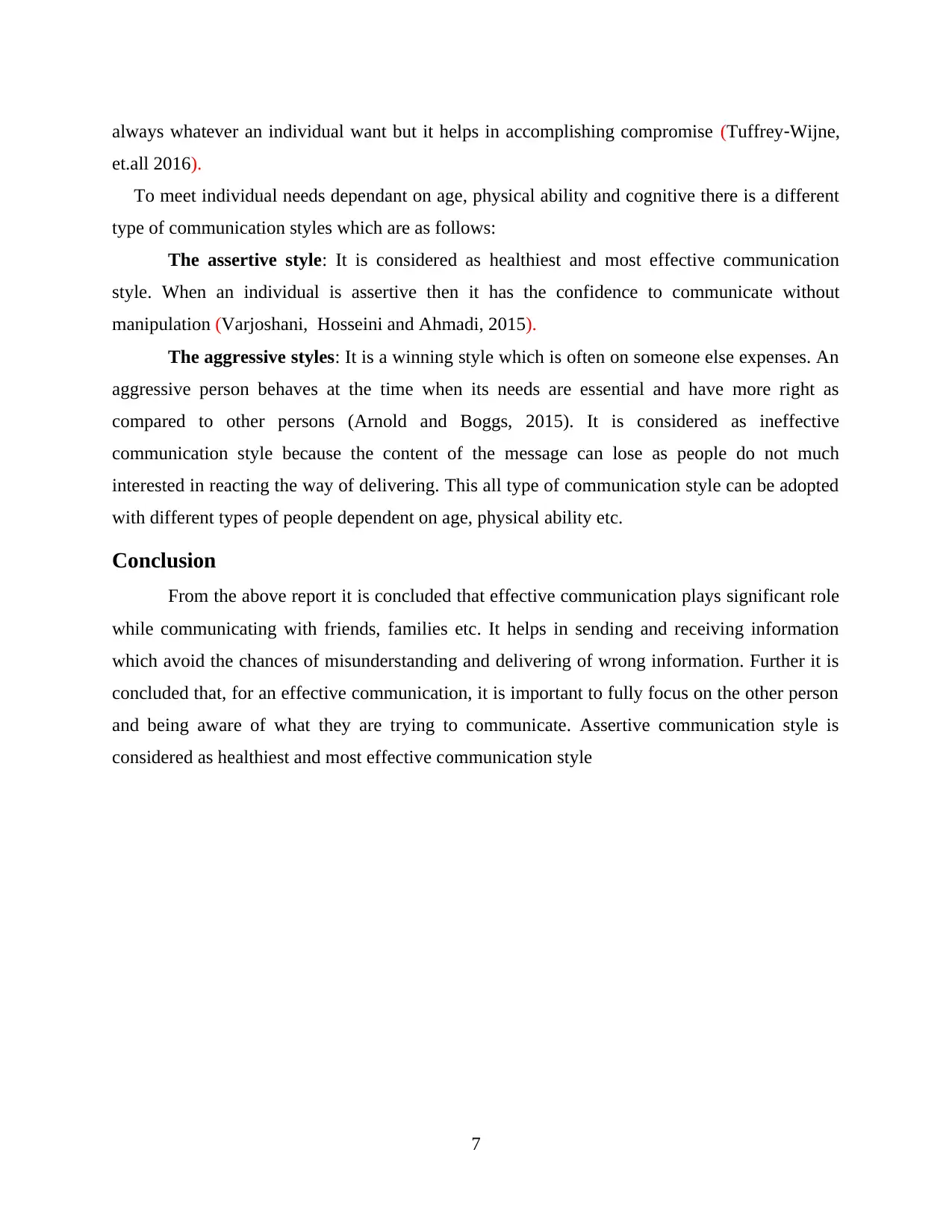
always whatever an individual want but it helps in accomplishing compromise (Tuffrey‐Wijne,
et.all 2016).
To meet individual needs dependant on age, physical ability and cognitive there is a different
type of communication styles which are as follows:
The assertive style: It is considered as healthiest and most effective communication
style. When an individual is assertive then it has the confidence to communicate without
manipulation (Varjoshani, Hosseini and Ahmadi, 2015).
The aggressive styles: It is a winning style which is often on someone else expenses. An
aggressive person behaves at the time when its needs are essential and have more right as
compared to other persons (Arnold and Boggs, 2015). It is considered as ineffective
communication style because the content of the message can lose as people do not much
interested in reacting the way of delivering. This all type of communication style can be adopted
with different types of people dependent on age, physical ability etc.
Conclusion
From the above report it is concluded that effective communication plays significant role
while communicating with friends, families etc. It helps in sending and receiving information
which avoid the chances of misunderstanding and delivering of wrong information. Further it is
concluded that, for an effective communication, it is important to fully focus on the other person
and being aware of what they are trying to communicate. Assertive communication style is
considered as healthiest and most effective communication style
7
et.all 2016).
To meet individual needs dependant on age, physical ability and cognitive there is a different
type of communication styles which are as follows:
The assertive style: It is considered as healthiest and most effective communication
style. When an individual is assertive then it has the confidence to communicate without
manipulation (Varjoshani, Hosseini and Ahmadi, 2015).
The aggressive styles: It is a winning style which is often on someone else expenses. An
aggressive person behaves at the time when its needs are essential and have more right as
compared to other persons (Arnold and Boggs, 2015). It is considered as ineffective
communication style because the content of the message can lose as people do not much
interested in reacting the way of delivering. This all type of communication style can be adopted
with different types of people dependent on age, physical ability etc.
Conclusion
From the above report it is concluded that effective communication plays significant role
while communicating with friends, families etc. It helps in sending and receiving information
which avoid the chances of misunderstanding and delivering of wrong information. Further it is
concluded that, for an effective communication, it is important to fully focus on the other person
and being aware of what they are trying to communicate. Assertive communication style is
considered as healthiest and most effective communication style
7
Paraphrase This Document
Need a fresh take? Get an instant paraphrase of this document with our AI Paraphraser
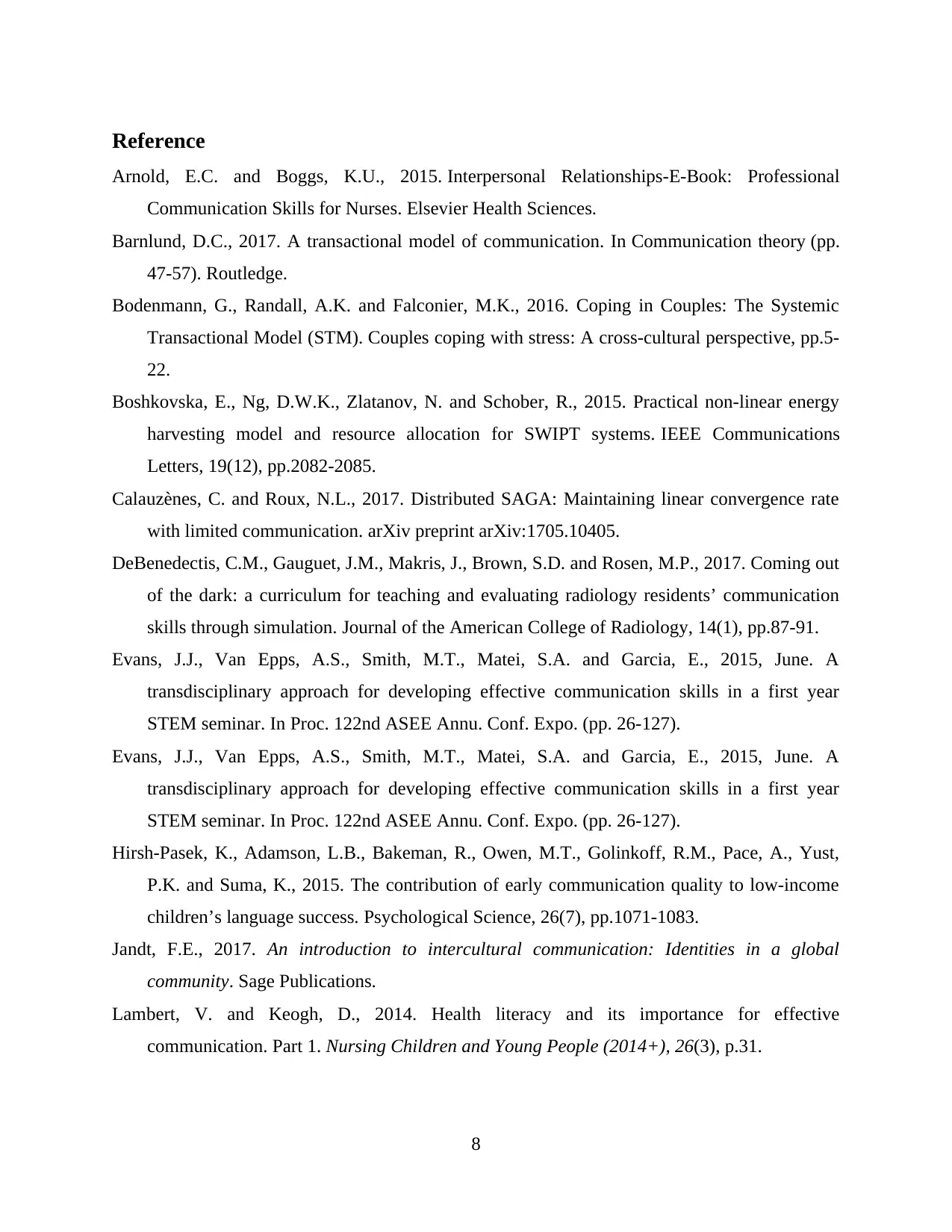
Reference
Arnold, E.C. and Boggs, K.U., 2015. Interpersonal Relationships-E-Book: Professional
Communication Skills for Nurses. Elsevier Health Sciences.
Barnlund, D.C., 2017. A transactional model of communication. In Communication theory (pp.
47-57). Routledge.
Bodenmann, G., Randall, A.K. and Falconier, M.K., 2016. Coping in Couples: The Systemic
Transactional Model (STM). Couples coping with stress: A cross-cultural perspective, pp.5-
22.
Boshkovska, E., Ng, D.W.K., Zlatanov, N. and Schober, R., 2015. Practical non-linear energy
harvesting model and resource allocation for SWIPT systems. IEEE Communications
Letters, 19(12), pp.2082-2085.
Calauzènes, C. and Roux, N.L., 2017. Distributed SAGA: Maintaining linear convergence rate
with limited communication. arXiv preprint arXiv:1705.10405.
DeBenedectis, C.M., Gauguet, J.M., Makris, J., Brown, S.D. and Rosen, M.P., 2017. Coming out
of the dark: a curriculum for teaching and evaluating radiology residents’ communication
skills through simulation. Journal of the American College of Radiology, 14(1), pp.87-91.
Evans, J.J., Van Epps, A.S., Smith, M.T., Matei, S.A. and Garcia, E., 2015, June. A
transdisciplinary approach for developing effective communication skills in a first year
STEM seminar. In Proc. 122nd ASEE Annu. Conf. Expo. (pp. 26-127).
Evans, J.J., Van Epps, A.S., Smith, M.T., Matei, S.A. and Garcia, E., 2015, June. A
transdisciplinary approach for developing effective communication skills in a first year
STEM seminar. In Proc. 122nd ASEE Annu. Conf. Expo. (pp. 26-127).
Hirsh-Pasek, K., Adamson, L.B., Bakeman, R., Owen, M.T., Golinkoff, R.M., Pace, A., Yust,
P.K. and Suma, K., 2015. The contribution of early communication quality to low-income
children’s language success. Psychological Science, 26(7), pp.1071-1083.
Jandt, F.E., 2017. An introduction to intercultural communication: Identities in a global
community. Sage Publications.
Lambert, V. and Keogh, D., 2014. Health literacy and its importance for effective
communication. Part 1. Nursing Children and Young People (2014+), 26(3), p.31.
8
Arnold, E.C. and Boggs, K.U., 2015. Interpersonal Relationships-E-Book: Professional
Communication Skills for Nurses. Elsevier Health Sciences.
Barnlund, D.C., 2017. A transactional model of communication. In Communication theory (pp.
47-57). Routledge.
Bodenmann, G., Randall, A.K. and Falconier, M.K., 2016. Coping in Couples: The Systemic
Transactional Model (STM). Couples coping with stress: A cross-cultural perspective, pp.5-
22.
Boshkovska, E., Ng, D.W.K., Zlatanov, N. and Schober, R., 2015. Practical non-linear energy
harvesting model and resource allocation for SWIPT systems. IEEE Communications
Letters, 19(12), pp.2082-2085.
Calauzènes, C. and Roux, N.L., 2017. Distributed SAGA: Maintaining linear convergence rate
with limited communication. arXiv preprint arXiv:1705.10405.
DeBenedectis, C.M., Gauguet, J.M., Makris, J., Brown, S.D. and Rosen, M.P., 2017. Coming out
of the dark: a curriculum for teaching and evaluating radiology residents’ communication
skills through simulation. Journal of the American College of Radiology, 14(1), pp.87-91.
Evans, J.J., Van Epps, A.S., Smith, M.T., Matei, S.A. and Garcia, E., 2015, June. A
transdisciplinary approach for developing effective communication skills in a first year
STEM seminar. In Proc. 122nd ASEE Annu. Conf. Expo. (pp. 26-127).
Evans, J.J., Van Epps, A.S., Smith, M.T., Matei, S.A. and Garcia, E., 2015, June. A
transdisciplinary approach for developing effective communication skills in a first year
STEM seminar. In Proc. 122nd ASEE Annu. Conf. Expo. (pp. 26-127).
Hirsh-Pasek, K., Adamson, L.B., Bakeman, R., Owen, M.T., Golinkoff, R.M., Pace, A., Yust,
P.K. and Suma, K., 2015. The contribution of early communication quality to low-income
children’s language success. Psychological Science, 26(7), pp.1071-1083.
Jandt, F.E., 2017. An introduction to intercultural communication: Identities in a global
community. Sage Publications.
Lambert, V. and Keogh, D., 2014. Health literacy and its importance for effective
communication. Part 1. Nursing Children and Young People (2014+), 26(3), p.31.
8
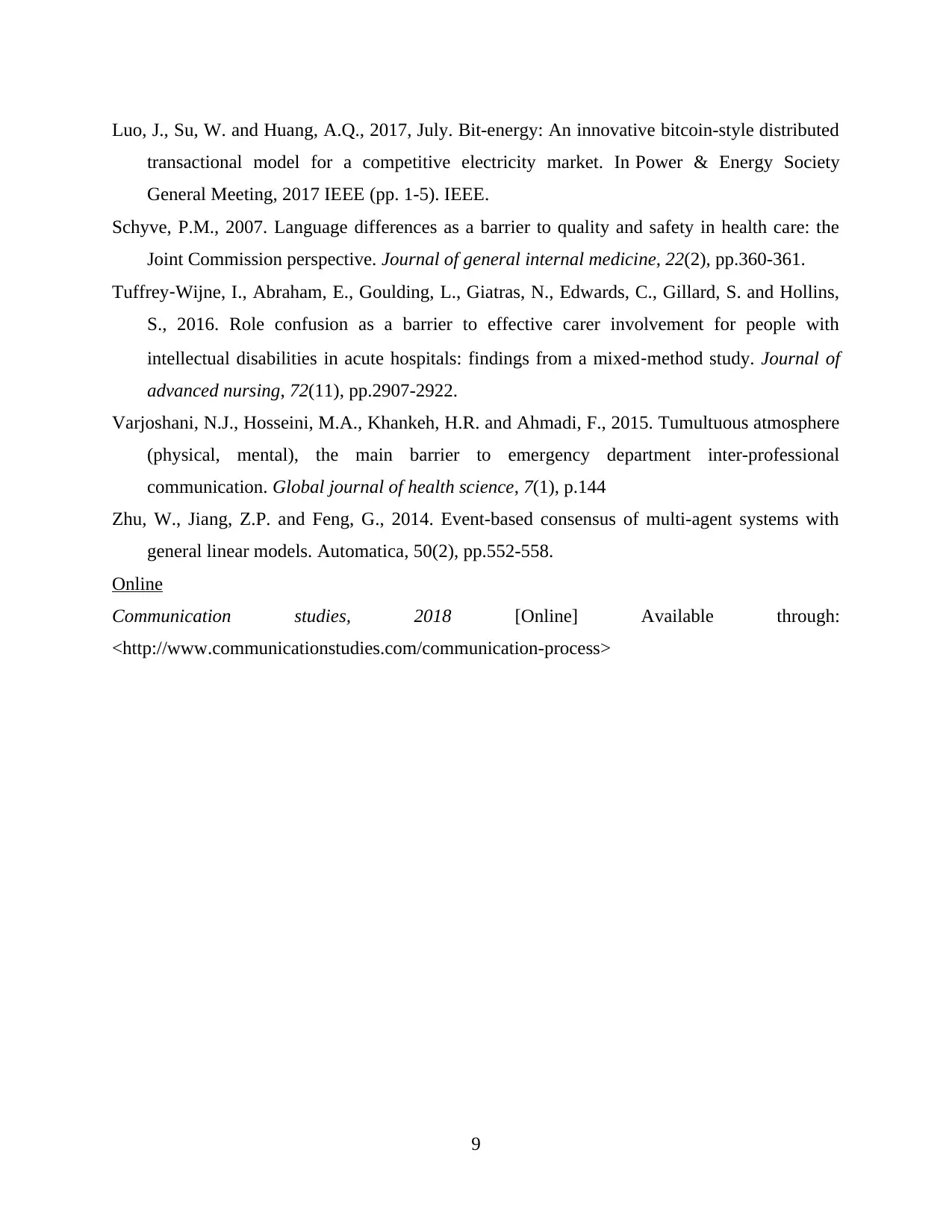
Luo, J., Su, W. and Huang, A.Q., 2017, July. Bit-energy: An innovative bitcoin-style distributed
transactional model for a competitive electricity market. In Power & Energy Society
General Meeting, 2017 IEEE (pp. 1-5). IEEE.
Schyve, P.M., 2007. Language differences as a barrier to quality and safety in health care: the
Joint Commission perspective. Journal of general internal medicine, 22(2), pp.360-361.
Tuffrey‐Wijne, I., Abraham, E., Goulding, L., Giatras, N., Edwards, C., Gillard, S. and Hollins,
S., 2016. Role confusion as a barrier to effective carer involvement for people with
intellectual disabilities in acute hospitals: findings from a mixed‐method study. Journal of
advanced nursing, 72(11), pp.2907-2922.
Varjoshani, N.J., Hosseini, M.A., Khankeh, H.R. and Ahmadi, F., 2015. Tumultuous atmosphere
(physical, mental), the main barrier to emergency department inter-professional
communication. Global journal of health science, 7(1), p.144
Zhu, W., Jiang, Z.P. and Feng, G., 2014. Event-based consensus of multi-agent systems with
general linear models. Automatica, 50(2), pp.552-558.
Online
Communication studies, 2018 [Online] Available through:
<http://www.communicationstudies.com/communication-process>
9
transactional model for a competitive electricity market. In Power & Energy Society
General Meeting, 2017 IEEE (pp. 1-5). IEEE.
Schyve, P.M., 2007. Language differences as a barrier to quality and safety in health care: the
Joint Commission perspective. Journal of general internal medicine, 22(2), pp.360-361.
Tuffrey‐Wijne, I., Abraham, E., Goulding, L., Giatras, N., Edwards, C., Gillard, S. and Hollins,
S., 2016. Role confusion as a barrier to effective carer involvement for people with
intellectual disabilities in acute hospitals: findings from a mixed‐method study. Journal of
advanced nursing, 72(11), pp.2907-2922.
Varjoshani, N.J., Hosseini, M.A., Khankeh, H.R. and Ahmadi, F., 2015. Tumultuous atmosphere
(physical, mental), the main barrier to emergency department inter-professional
communication. Global journal of health science, 7(1), p.144
Zhu, W., Jiang, Z.P. and Feng, G., 2014. Event-based consensus of multi-agent systems with
general linear models. Automatica, 50(2), pp.552-558.
Online
Communication studies, 2018 [Online] Available through:
<http://www.communicationstudies.com/communication-process>
9
⊘ This is a preview!⊘
Do you want full access?
Subscribe today to unlock all pages.

Trusted by 1+ million students worldwide
1 out of 9
Related Documents
Your All-in-One AI-Powered Toolkit for Academic Success.
+13062052269
info@desklib.com
Available 24*7 on WhatsApp / Email
![[object Object]](/_next/static/media/star-bottom.7253800d.svg)
Unlock your academic potential
Copyright © 2020–2025 A2Z Services. All Rights Reserved. Developed and managed by ZUCOL.





